Tom's Hardware Verdict
The M75 Wireless is a solid, well-performing gaming mouse, but the only thing that really makes it stand out are its right-side thumb buttons.
Pros
- +
Truly ambidextrous design
- +
Comfortable
- +
Can use all four thumb buttons if you want
Cons
- -
Not particularly interesting aside from the appeal to lefties
- -
Lackluster RGB
- -
Still a little heavy
Why you can trust Tom's Hardware
It's hard out here for a leftie looking for one of the best gaming mice. Don't get me wrong, there are plenty of good symmetrical gaming mice on the market, such as the Logitech G Pro X Superlight 2 and the Razer Cobra Pro — but symmetrical in shape does not mean truly ambidextrous. Both of those mice only have thumb buttons on the left side — meaning they're still designed for right-handed users, even if their shape means that left-handed users can technically use them.
But Corsair's newest symmetrical mouse is truly ambidextrous: The M75, which comes in both a wired and a wireless version, has thumb buttons on both sides — and they can be swapped out for flat buttons, so you don't have to feel the buttons on the side you're not using. Corsair sent over both the wired M75 and the M75 Wireless for review; because the mice are so similar, this review will focus on the M75 Wireless but it largely applies to both products. The M75 is available now, and costs $79.99 for the wired version (black only) and $129.99 for the wireless version (black and white).
Design and Comfort of the M75 Wireless
The M75 Wireless features a symmetrical shape that's truly ambidextrous — with interchangeable thumb buttons on both sides of the mouse. It comes in both black and white colorways, with a smooth, lightweight plastic shell that has two slim stripes of lighting that taper down toward the bottom, where Corsair's ship logo also lights up.
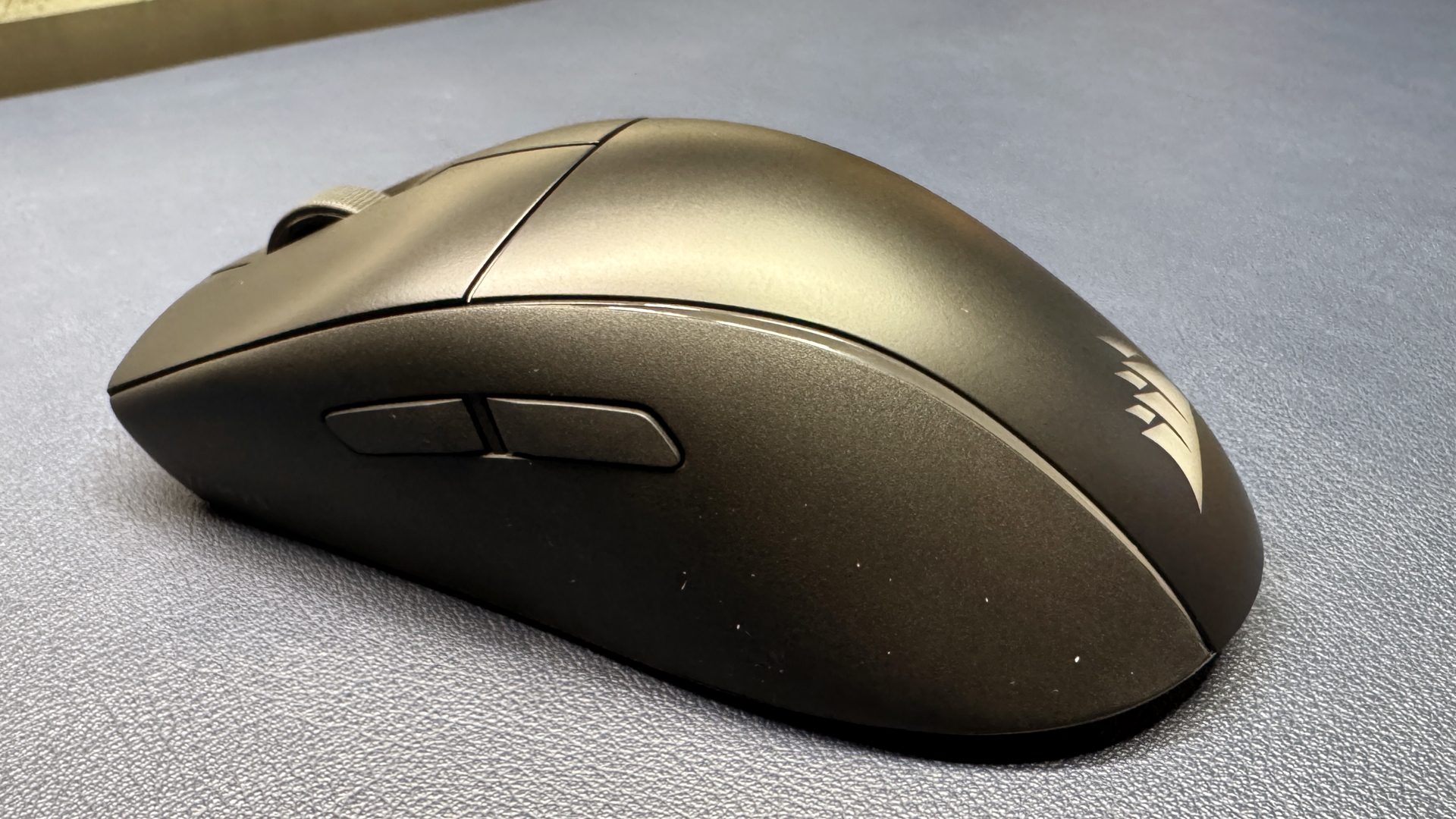
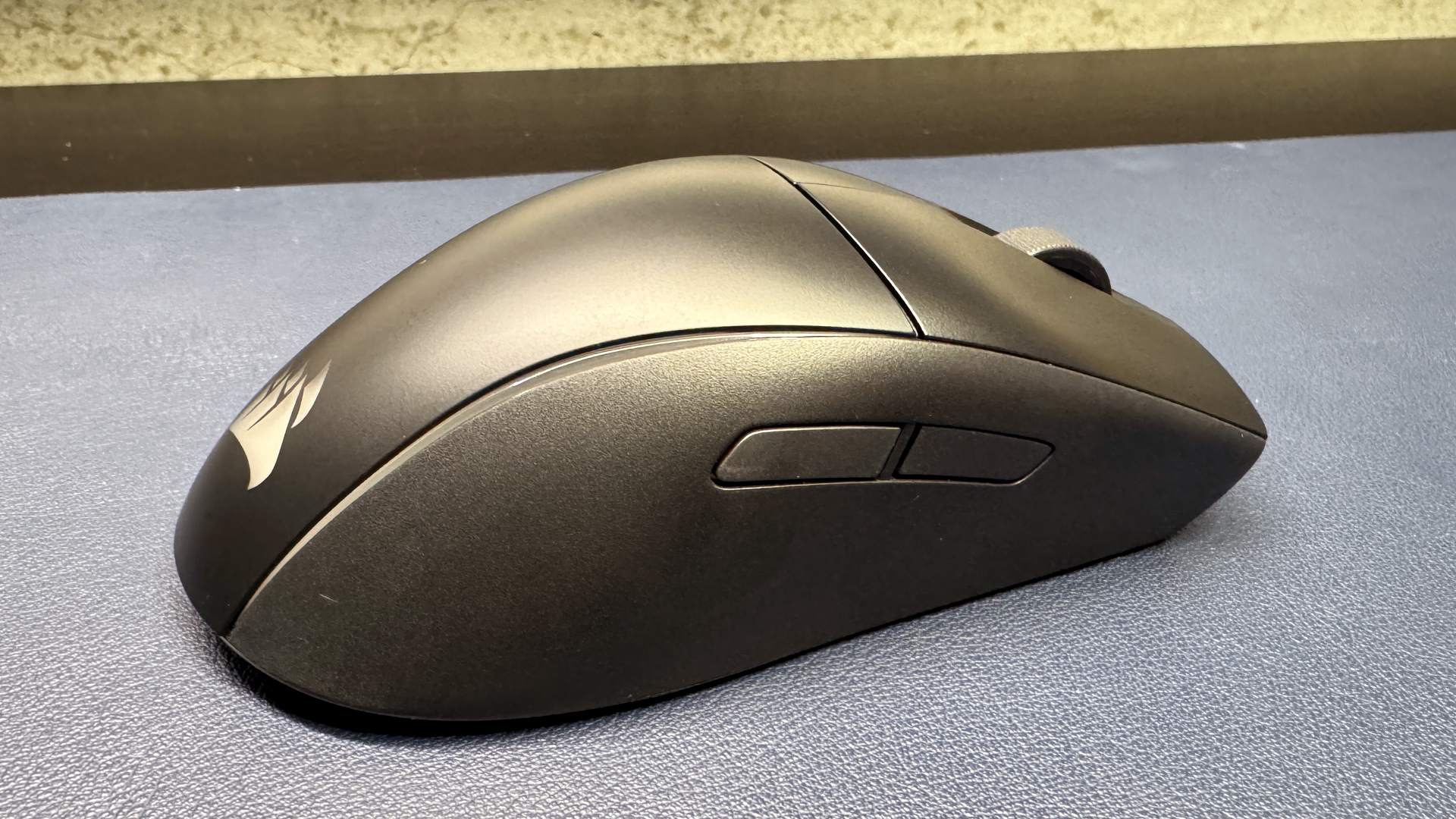
The mouse comes configured by default as a right-handed mouse, with raised thumb buttons on the left side. In the box are four extra thumb buttons that can be swapped in as you like — two flat buttons for the left side and two raised buttons for the right side. While Corsair describes the button options as either "raised" or "smooth, non-clickable buttons," the flat buttons are not, in fact, non-clickable — they're flat, and flush with the mouse's surface, but they're still very clickable and they continue to work as configured when swapped in.
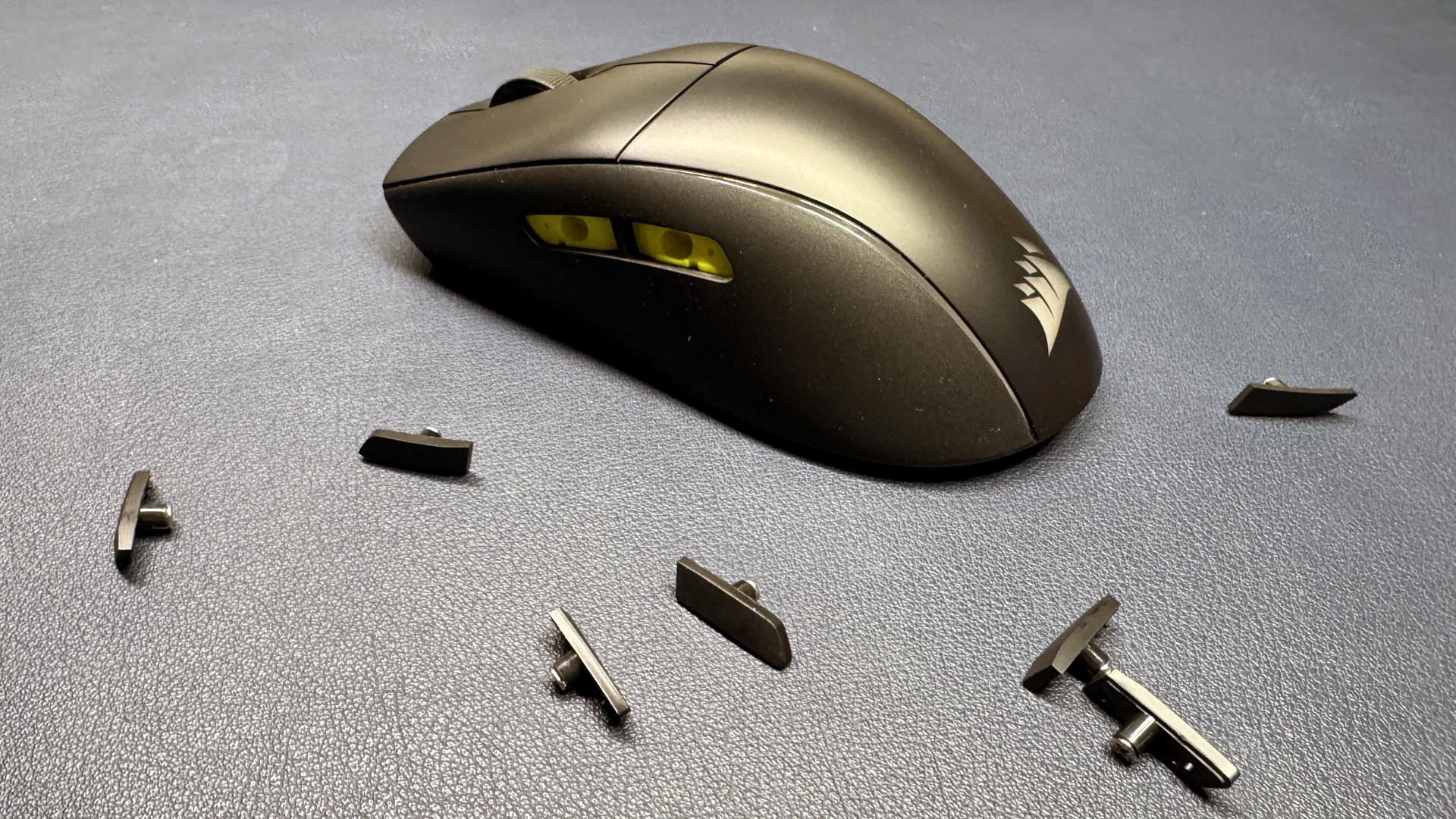
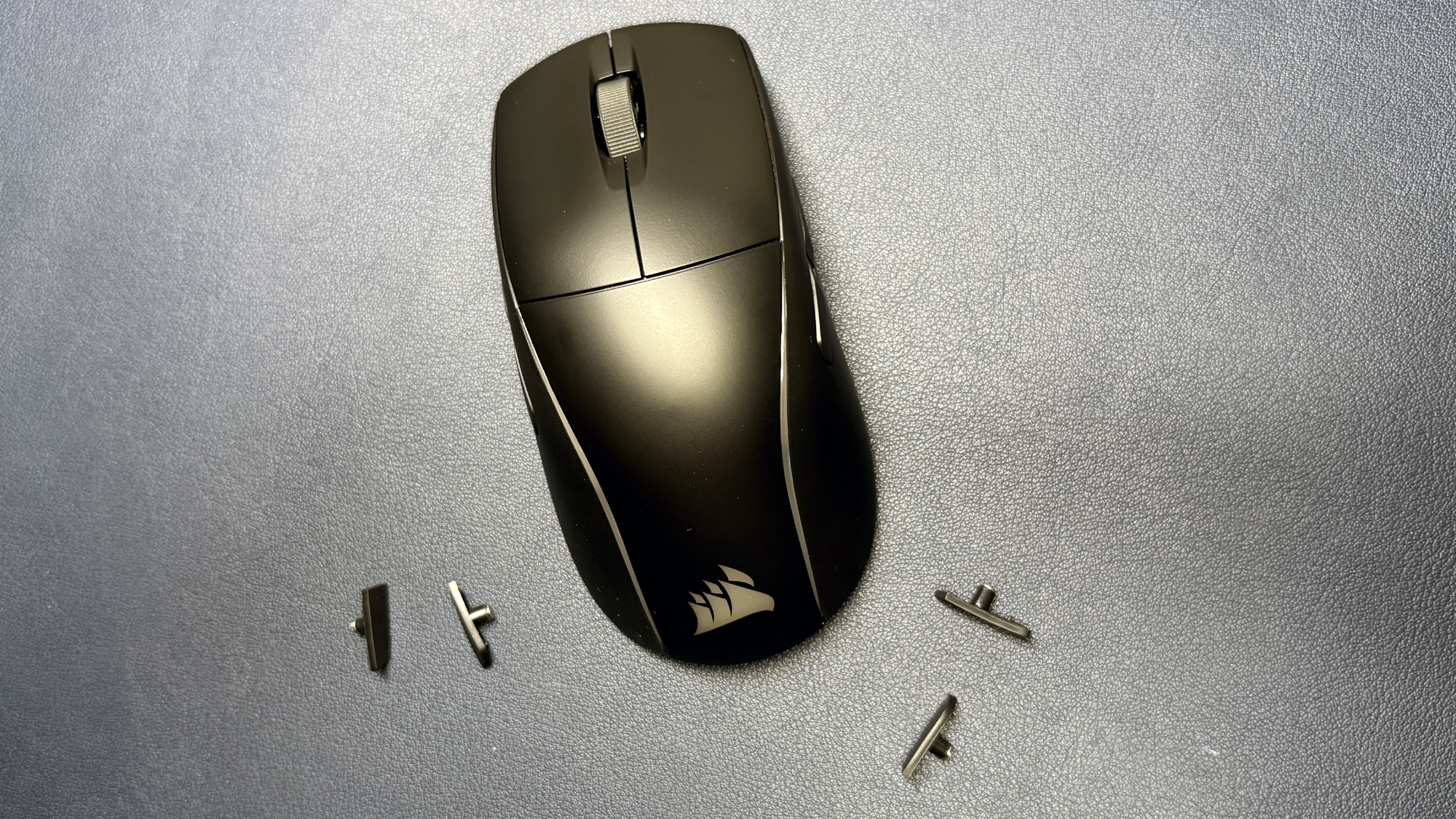

You can, of course, turn them off in Corsair's iCue peripheral software. There's a toggle for switching between right- and left-handed mode — which turns off the left-side buttons and the right-side buttons, respectively — as well as a toggle for enabling all buttons; if you want to turn all side buttons off, you'll need to do that manually. But if you were wondering if swapping in the flat buttons somehow prevents those side buttons from functioning, it doesn't. These are not button deletes, like you'll find on some mice with swappable buttons (such as the Glorious Model I 2 Wireless).
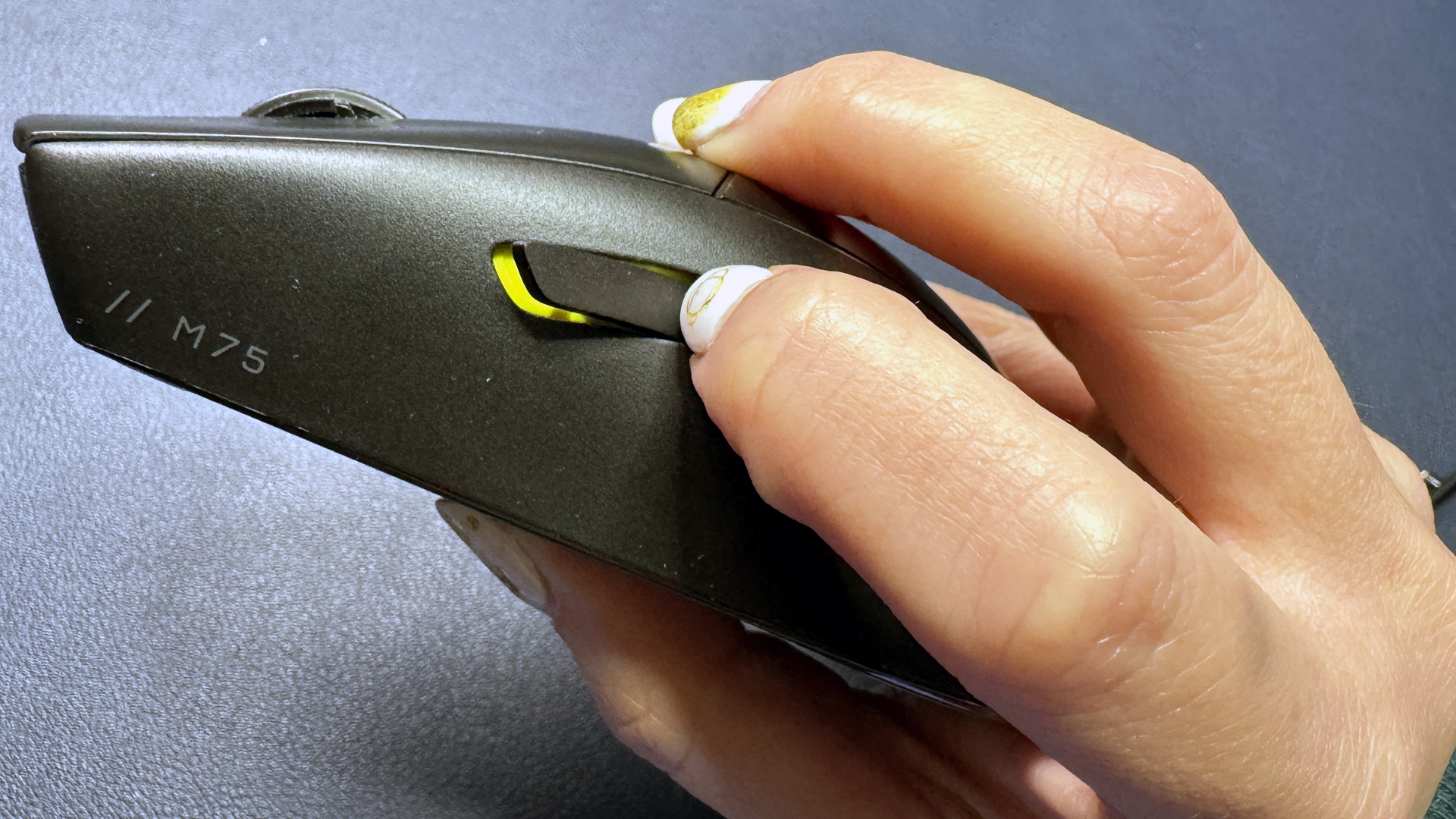

The side buttons are magnetic and are easy to switch out. All you have to do is press the inside of the button and it pops out easily — no tools necessary.

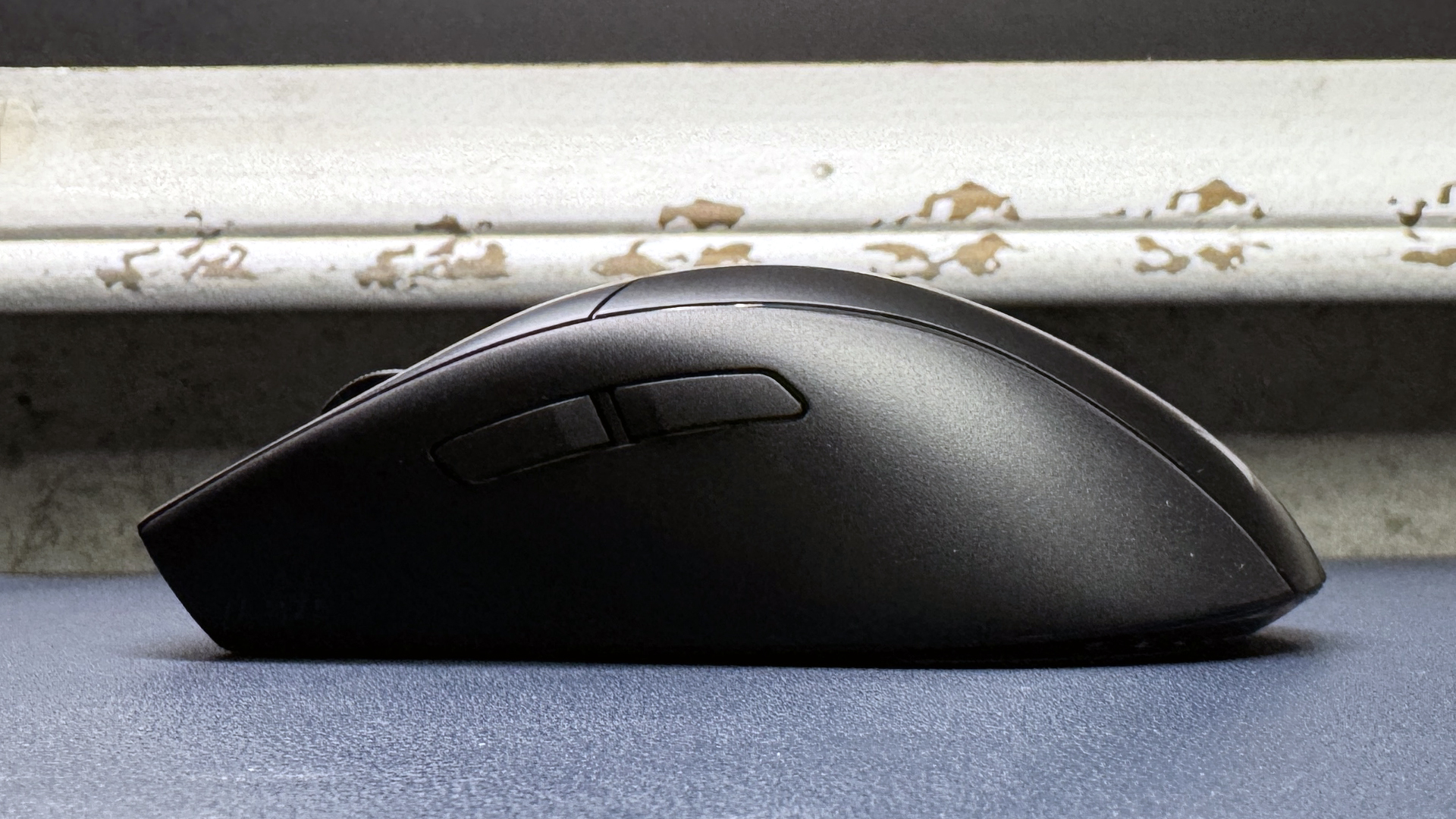
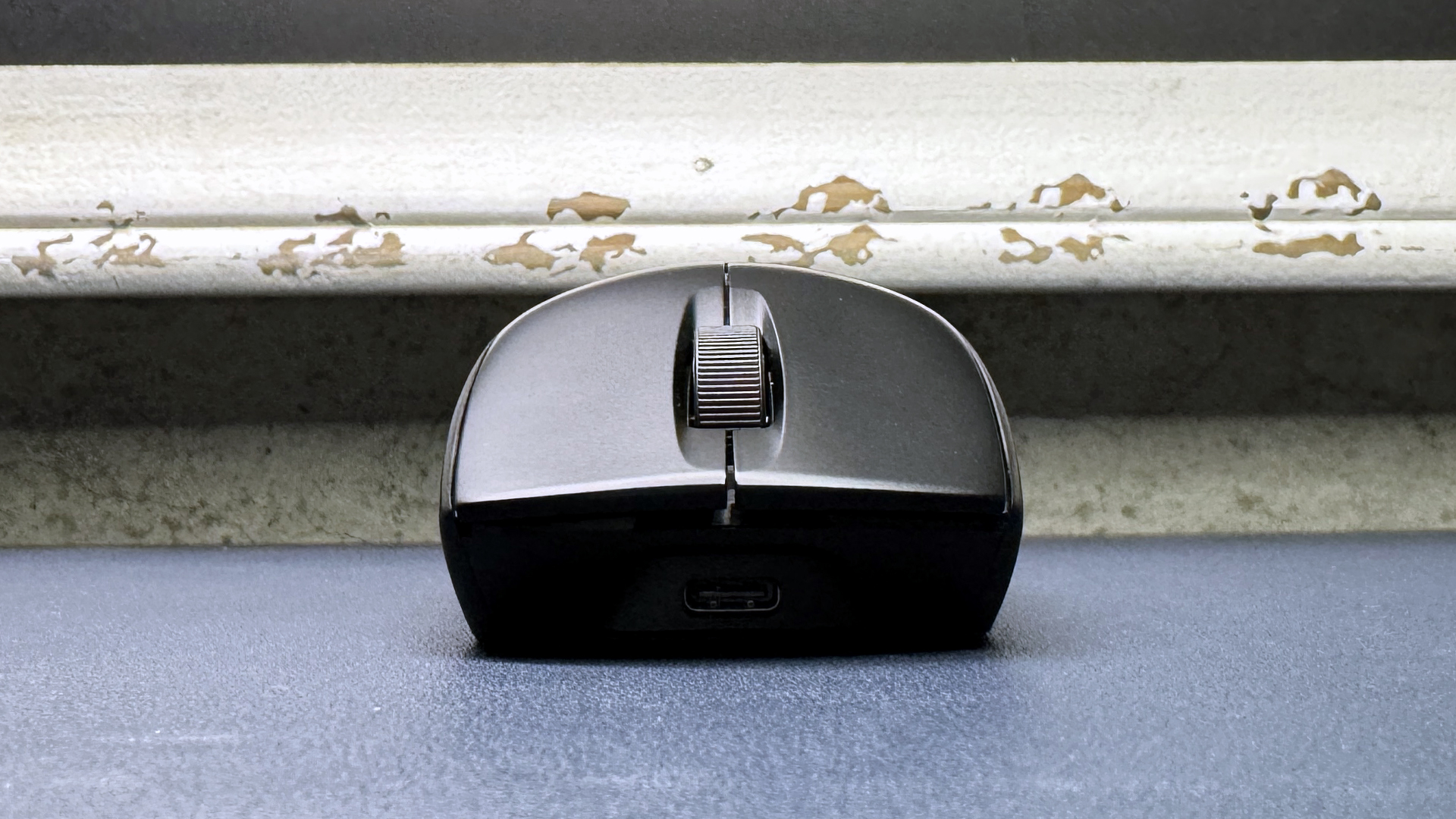
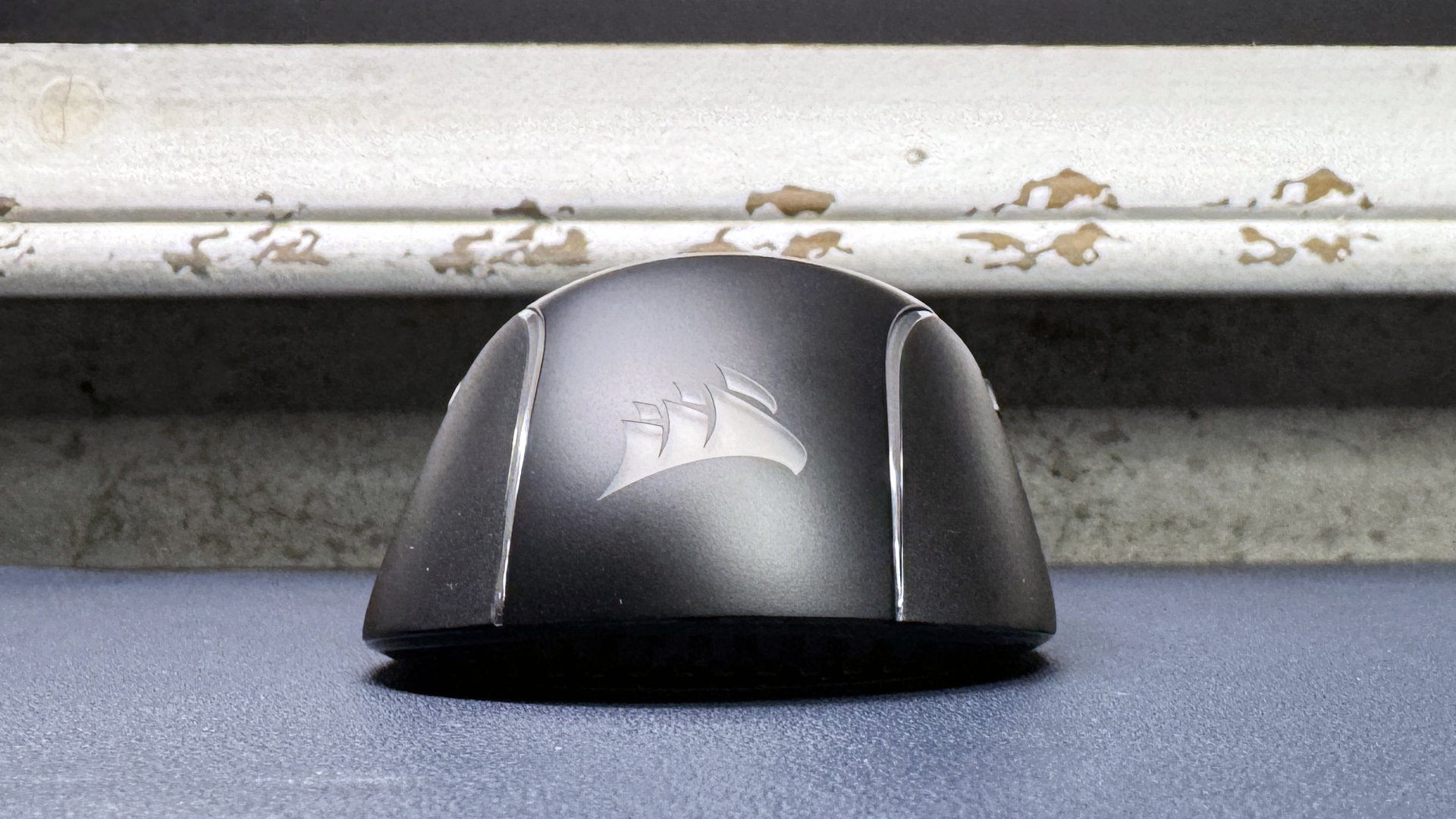
The M75 Wireless is a relatively large mouse, measuring 5.04 inches (128mm) long by 2.56 inches (64.6mm) wide, and is 1.64 inches (42mm) high at its thickest point. It has a somewhat generic shape that tapers toward the front and curves slightly for grip. The M75 Wireless weighs 3.14oz (89g) — a little too heavy to be considered an ultra-lightweight mouse (the wired version weighs 2.61oz / 74g). If you're looking for an ultra-lightweight mouse, Corsair also sells the M75 Air, which weighs 2.12oz (60g) and looks very similar to the M75 Wireless, but doesn't have the right-side thumb buttons for left-handed users.
Get Tom's Hardware's best news and in-depth reviews, straight to your inbox.
The mouse has nine buttons if you include the clickable scroll wheel, six of which are programmable. Well, technically seven are programmable, but Corsair doesn't allow you to reprogram the primary click (the left button in right-handed mode; the right button in left-handed mode). The scroll wheel is notched and feels sturdy — it's a little stiffer than I prefer, but this didn't bother me too much in my testing.
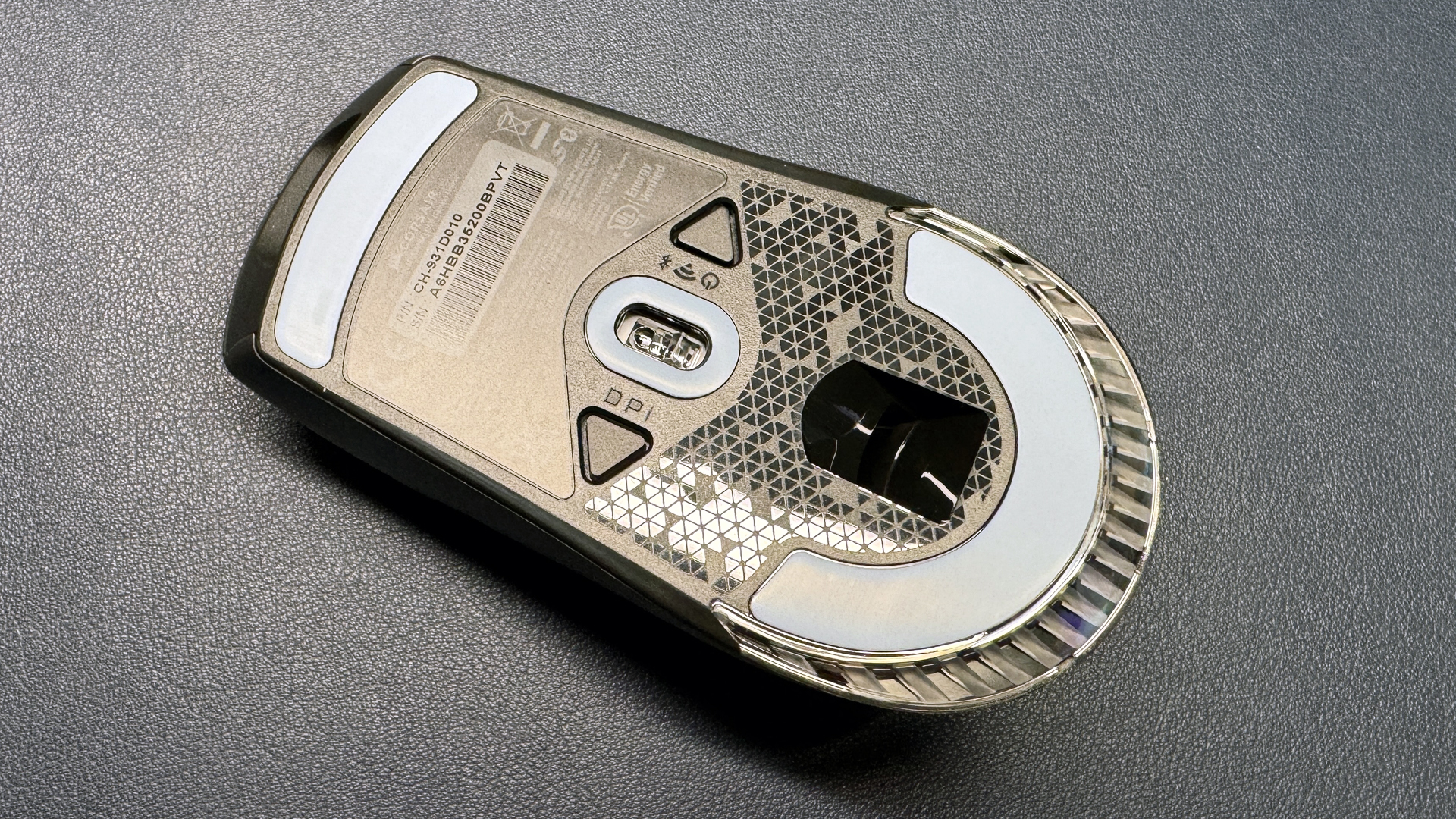
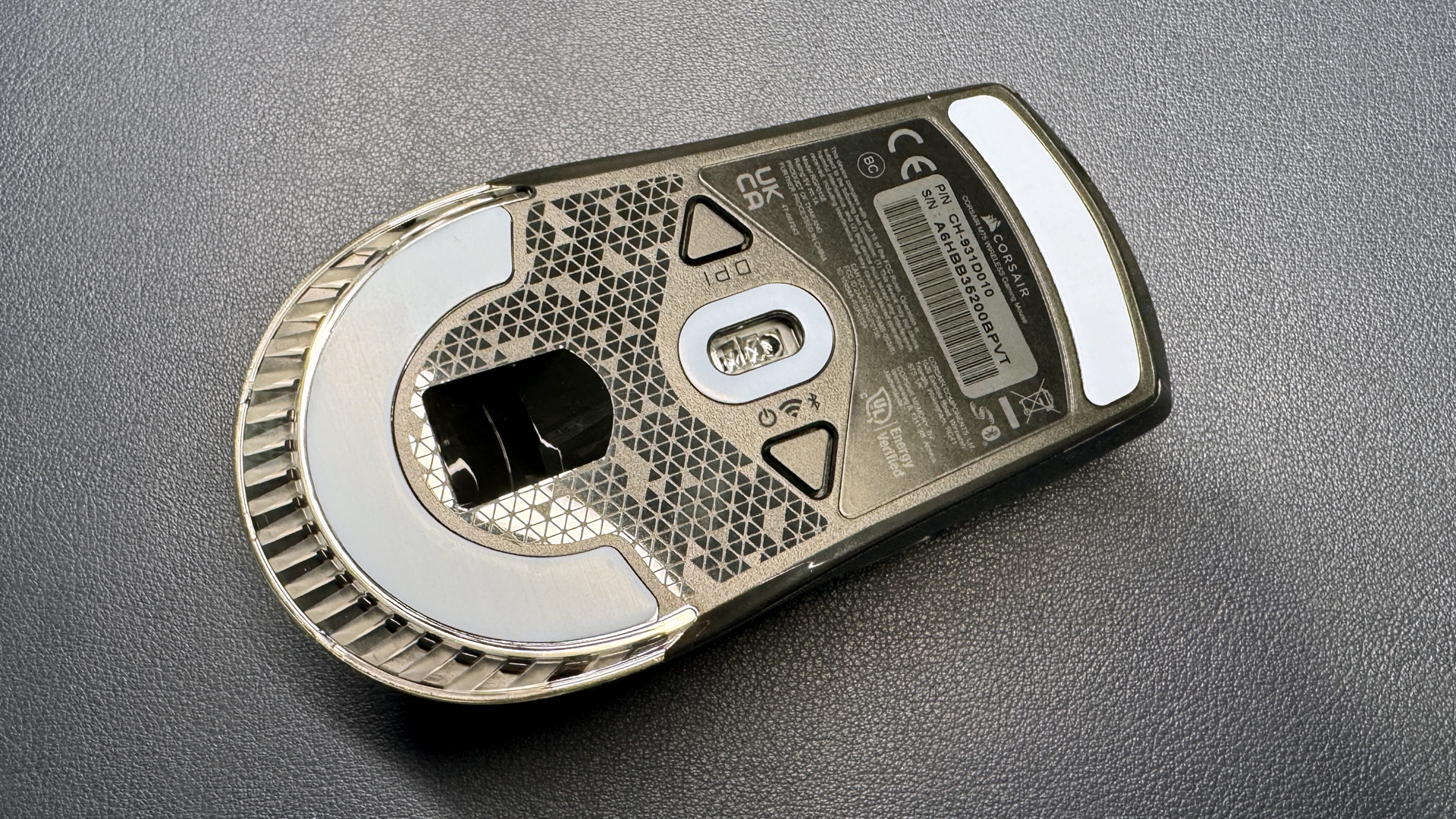
On the bottom of the mouse you'll find two large PTFE strips along the top and bottom edges, as well as a PTFE strip surrounding the sensor. On either side of the sensor there are two triangular buttons — one for power and switching between 2.4GHz wireless and Bluetooth, and one for switching between DPI steps, which can be configured in iCue. There's also a hollowed-out storage area for the mouse's 2.4GHz wireless USB-A dongle, which is always a nice touch.
In addition to the extra buttons and the 2.4GHz wireless dongle, the M75 Wireless also comes with a 6-foot (1.8m) braided USB-C to USB-A cable for charging. The cable is of decent quality, but it's not an ultra-flexible low-drag cable like some companies package with their mice (e.g. Razer's "SpeedFlex" cables) — if you use the M75 Wireless while charging, you'll experience some cable drag. It's not too bad, but you'll definitely feel it. The wired M75's attached cable is similarly stiff; if you're looking for a wired mouse with a lightweight, drag-free cable, I'd recommend the HyperX Pulsefire Haste 2.
Specs
| Sensor Model | Corsair Marksman Optical Sensor |
| Max Sensitivity | 26,000 DPI |
| Max Speed (IPS) | 650 IPS |
| Max Acceleration | 50 G |
| Polling Rates | 2,000 Hz |
| Programmable Buttons | 5 (6 including scroll wheel click) |
| LED Zones | 2 |
| Cable | 6ft / 1.8m USB-C to USB-A |
| Connectivity | 2.4GHz wireless, Bluetooth, wired (USB-C) |
| Measurements (L x W x H) | 5.04 x 2.56 x 1.64 inches / 128 x 64.6 x 42mm |
| Weight (excluding cable) | 3.14oz / 89g |
| MSRP / Price at Time of Review | $129.99 / $129.99 |
| Release Date | Feb. 29, 2024 |
Performance of the M75 Wireless
The M75 Wireless sports Corsair's Marksman 26K optical sensor, which has a maximum sensitivity of 26,000 DPI, a maximum speed of 650 IPS, and can handle up to 50 G's of acceleration. It has optical left- and right-click switches, with zero delay between the buttons and their switches for instant, speedy clicks. The buttons offer a nice amount of tactile feedback and clickiness without being too stiff, though they are slightly on the louder side.
The M75 Wireless performed expectedly well: its sensor had no issues tracking on a variety of surfaces (wood, paper, carpet, concrete, and various mouse pads, including a glass mouse pad), I experienced no issues with lag, connectivity, or latency, and the mouse felt responsive and accurate at all times — even when waking from sleep or running low on batteries.
This is far from the lightest mouse on the market, but it glides well across most surfaces thanks to its pure PTFE feet and its (relatively) light weight. I didn't have too much difficulty flicking or swiping quickly, and I was able to pick it up and move it pretty easily (its slightly-tapered shape kept it from slipping through my fingers), but it's still noticeably heavier than ultra-lightweight mice such as the Logitech G Pro X Superlight 2. Overall, it's a very comfortable mouse despite its relatively generic-looking shape, and as long as you're not planning on picking it up too often the slightly heavier weight probably won't be an issue for most gamers.
While the M75 Wireless does technically have four programmable side buttons, you're most likely only going to use two with any regularity. The left-side buttons (I'm right-handed) are well-placed and easy to click, so I can only assume the same is true of the right-side buttons. As I noted earlier, the flat buttons you can swap in don't actually prevent the buttons from working, and you will accidentally press them if they're turned on. This shouldn't be too much of an issue, however, as they're turned off by default (the right buttons are turned off by default; the left buttons are turned off by default if you're using the mouse in left-handed mode).
Features and Software of the M75 Wireless
The M75 Wireless is configurable via Corsair's iCue software. With iCue, you can program the mouse's six programmable buttons — the right mouse button (or, in left-handed mode, the left mouse button), all four thumb buttons, and the scroll wheel click. You can also configure the mouse's RGB lighting and DPI steps, and set both key assignments and lighting for the mouse's onboard profile (only one).

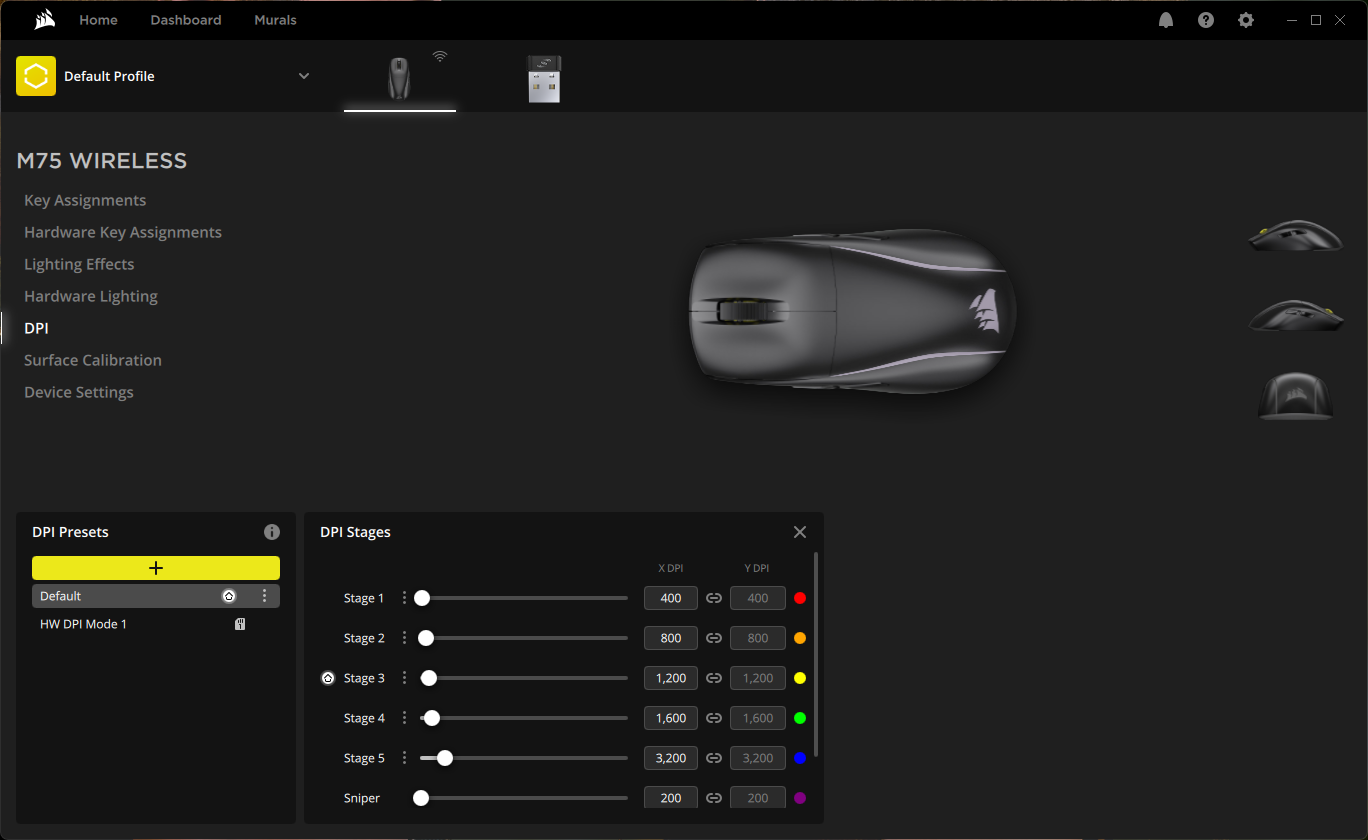
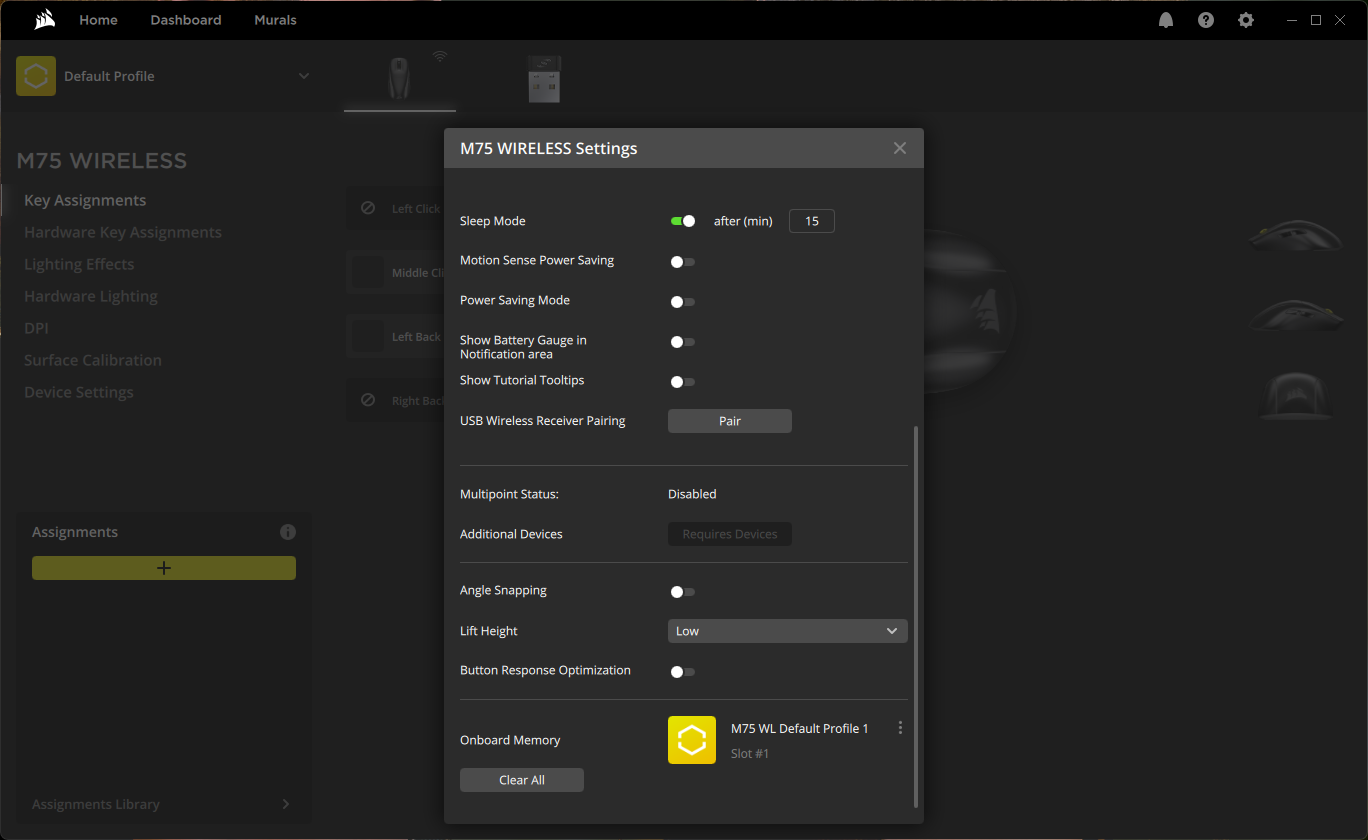
There's also a Device Settings menu in iCue, where you can toggle on left-handed mode or enable all side buttons, change the mouse's RGB lighting brightness, and toggle options such as angle snapping and button response optimization, and adjust the lift-off height. You can't adjust the mouse's polling rate, which is set at Corsair's "Slipstream" wireless polling rate of "up to" 2,000 Hz.
The M75 Wireless has two RGB lighting zones — the logo and the two stripes along its side are one zone and the underglow (along the back edge of the mouse) is another zone. It's not my favorite way to implement RGB, because it doesn't allow for attractive color blending across zones like you'll see on Logitech's G502 X Plus.
You can program each zone independently and they don't really interact with each other. I'm not totally sure why the underglow section even exists here, as it's pretty lackluster. Cranking up the RGB lighting brightness to 100% gives you some underglow, but it's not nearly as bright or vibrant as you'll see from Razer's Cobra Pro, for example.
Wireless Experience and Battery Life of the M75 Wireless
The M75 Wireless offers three forms of connectivity: low-latency 2.4GHz wireless, Bluetooth, and wired (via USB-C). Corsair calls its version of 2.4GHz wireless "Slipstream" and says it gets up to a 2,000 Hz polling rate, which halves the latency of a 1,000 Hz polling rate (from 1ms to 0.5ms). This difference won't be noticeable to most people, but it can matter in games where speed of the essence — i.e., FPS games. (Of course, the M75 Wireless is a little heavier than most FPS-oriented mice.)
It's worth noting, however, that while the M75 Wireless' maximum polling rate is 2,000 Hz, the wired M75 mouse has a polling rate of up to 8,000 Hz — again, probably not noticeable to most gamers, but an 8,000 Hz polling rate cuts latency to just 0.125ms.
Corsair rates the M75 Wireless' battery life at 105 hours over 2.4GHz wireless with the RGB lighting turned off, which is pretty good — about what I'd expect from a mouse this size and weight. For context, the 80g Logitech G Pro Wireless, which also has both left and right thumb buttons, gets just 60 hours of battery life with the lighting turned off, while the M75 Wireless gets 65 hours of battery life with the lighting turned on (we'll assume that's at 50% brightness, not 100%).
Bottom Line
Corsair's M75 Wireless is a good option for left-handed gamers looking for a mouse with thumb buttons... mostly because it's one of the only options. It's a solid, reliable, relatively lightweight mouse with a generic-looking but surprisingly comfortable symmetrical shape, decent battery life, and a 2,000 Hz polling rate — all things that are great to see in a gaming mouse but are not particularly impressive or unique.
If you're looking for a mouse that has a symmetrical shape, there are plenty of options, but if you're looking for a mouse that has thumb buttons on the right side, there are only a couple of options — the Logitech G Pro Wireless, the older Razer Viper — and now the Corsair M75, both wired and wireless.

Sarah Jacobsson Purewal is a senior editor at Tom's Hardware covering peripherals, software, and custom builds. You can find more of her work in PCWorld, Macworld, TechHive, CNET, Gizmodo, Tom's Guide, PC Gamer, Men's Health, Men's Fitness, SHAPE, Cosmopolitan, and just about everywhere else.



